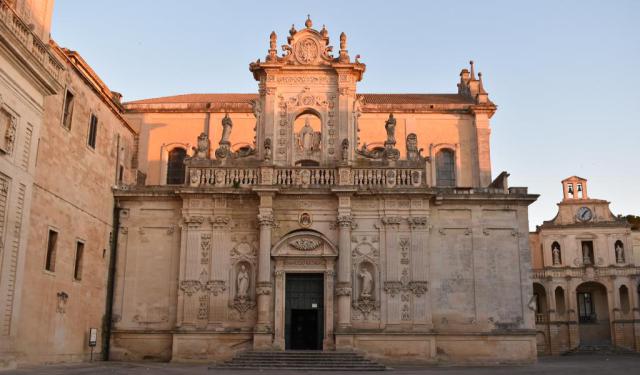
Chiesa di Sant'Irene (St. Irene Church), Lecce
The Saint Irene Church (Chiesa di Sant'Irene) is a remarkable Catholic place of worship located in the historic center of Lecce. It holds a special dedication to Saint Irene of Lecce, who served as the protector of the city until 1656 when Pope Alexander VII declared the patronage of Lecce to be held by another holy bishop, Saint Oronzo.
Construction of the church began in 1591 under the guidance of the Theatine architect Francesco Grimaldi and was finally completed in 1639. The consecration ceremony was conducted by the bishop of Brindisi, marking a significant milestone in the church's history.
Throughout the years, the Saint Irene Church has witnessed several significant historical events. In 1797, it received a visit from King Ferdinand IV of Naples, highlighting its importance and recognition. Additionally, in October 1860, the church played a crucial role in hosting the plebiscite operations to determine Lecce's decision to join the Kingdom of Italy. Despite the suppression of the adjoining Theatine convent in 1866, the church remained open for worship, emphasizing its enduring spiritual significance.
Architecturally, the church draws inspiration from the design of the Church of Sant'Andrea della Valle in Rome, where Francesco Grimaldi had previously worked. The facade of the Saint Irene Church features a double-order layout, characterized by superimposed pilasters adorned with festoons. The lower order incorporates columns interspersed with empty niches and cartouches, while the upper order showcases a large window, adding an element of grandeur and elegance to the structure.
Construction of the church began in 1591 under the guidance of the Theatine architect Francesco Grimaldi and was finally completed in 1639. The consecration ceremony was conducted by the bishop of Brindisi, marking a significant milestone in the church's history.
Throughout the years, the Saint Irene Church has witnessed several significant historical events. In 1797, it received a visit from King Ferdinand IV of Naples, highlighting its importance and recognition. Additionally, in October 1860, the church played a crucial role in hosting the plebiscite operations to determine Lecce's decision to join the Kingdom of Italy. Despite the suppression of the adjoining Theatine convent in 1866, the church remained open for worship, emphasizing its enduring spiritual significance.
Architecturally, the church draws inspiration from the design of the Church of Sant'Andrea della Valle in Rome, where Francesco Grimaldi had previously worked. The facade of the Saint Irene Church features a double-order layout, characterized by superimposed pilasters adorned with festoons. The lower order incorporates columns interspersed with empty niches and cartouches, while the upper order showcases a large window, adding an element of grandeur and elegance to the structure.
Want to visit this sight? Check out these Self-Guided Walking Tours in Lecce. Alternatively, you can download the mobile app "GPSmyCity: Walks in 1K+ Cities" from Apple App Store or Google Play Store. The app turns your mobile device to a personal tour guide and it works offline, so no data plan is needed when traveling abroad.
Chiesa di Sant'Irene (St. Irene Church) on Map
Sight Name: Chiesa di Sant'Irene (St. Irene Church)
Sight Location: Lecce, Italy (See walking tours in Lecce)
Sight Type: Religious
Guide(s) Containing This Sight:
Sight Location: Lecce, Italy (See walking tours in Lecce)
Sight Type: Religious
Guide(s) Containing This Sight:
Walking Tours in Lecce, Italy
Create Your Own Walk in Lecce
Creating your own self-guided walk in Lecce is easy and fun. Choose the city attractions that you want to see and a walk route map will be created just for you. You can even set your hotel as the start point of the walk.
Lecce Introduction Walking Tour
The beginning of Lecce is a legend. According to the story, a town existed close to the location of today's Lecce, dating from the Trojan Wars. The town was taken by Romans in the 3rd century BC. They called it "Lupiae." The Roman Emperor Hadrian didn't like the location, so he moved it 2 miles to the northeast. Lecce had a theatre and an amphitheater which can be partially... view more
Tour Duration: 2 Hour(s)
Travel Distance: 2.1 Km or 1.3 Miles
Tour Duration: 2 Hour(s)
Travel Distance: 2.1 Km or 1.3 Miles
Lecce's Baroque Churches Walking Tour
Often defined as the “Capital of Baroque” – an artistic trend born in Italy in the 17th century, the town of Lecce has this signature style present in most of the buildings throughout its historic center. Characterized by elaborate facades and the extensive use of local stone known as "pietra leccese", Lecce's Baroque architecture reached its pinnacle in the form of churches,... view more
Tour Duration: 1 Hour(s)
Travel Distance: 2.0 Km or 1.2 Miles
Tour Duration: 1 Hour(s)
Travel Distance: 2.0 Km or 1.2 Miles


